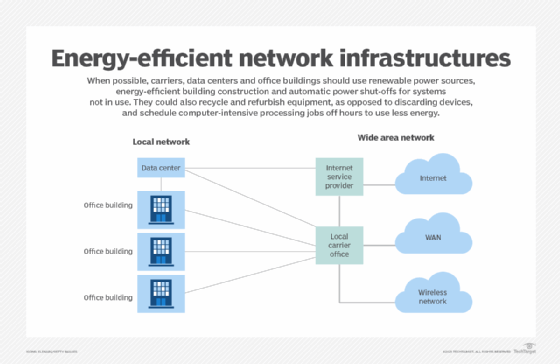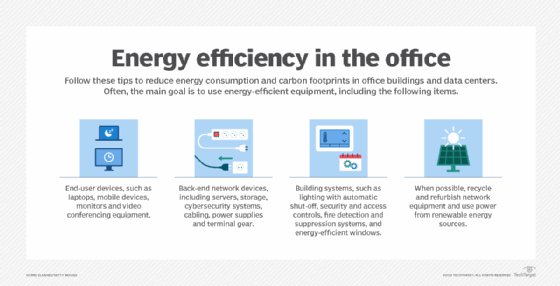
How to modernize networks with sustainability in mind
A network modernization project is a good time to consider sustainability initiatives, such as using energy-efficient devices and renewable energy sources.
When planning investments in network modernization, IT leaders should consider a strategy that embraces green networking and sustainability. Green networking uses networking devices and equipment in energy-efficient and eco-friendly ways.
While the network configuration and topology don't need to change, the equipment enabling the network can be more energy-efficient. This strategy is essential to ensure that network components can be used for longer periods of time, reducing carbon footprints, damage to the environment and energy usage, which are among the foundational elements of sustainability.
What is network sustainability?
Over the past two decades, studies confirmed that networking affects the environment primarily through energy usage, especially as it relates to the release of greenhouse gases into the atmosphere by power generation systems.
The internet, which comprises hundreds of data centers worldwide, is a huge user of energy resources. So too are hundreds of switching centers that connect businesses and consumers to the internet, wireless services, social media and each other. Cloud-based networks, such as AWS, Microsoft Azure and Google Cloud, are also significant energy users. Switching systems and computers located within the many network data centers all use considerable amounts of energy.
To ensure these resources can be sustained and stay functioning over time without causing more damage to the climate and environment, they must deploy energy-efficient and eco-friendly infrastructure elements wherever possible. This same network sustainability strategy extends into corporate networks that use a variety of switching and routing devices to deliver service to users. It also extends to wireless carriers that deliver much of today's information and resources, such as social media, to users.
How to create a sustainable network
A look at various network configurations can identify the elements that are either directly or indirectly responsible for damage to the environment. Figure 1 takes a high-level view of network infrastructures and how they can be more energy-efficient. The primary opportunity to reduce greenhouse gas emissions is to replace existing power sources with renewable energy from solar power and wind power, for example. Less dependence on power generated by fossil fuels can reduce the carbon footprint of switching offices, reducing emissions.

Incumbent local exchange carriers, cloud service providers (CSPs), wireless carriers, MSPs and ISPs are all candidates for reducing their carbon footprint and overall energy usage. Equipment used in switching offices can be replaced with energy-efficient units. Some devices can be refurbished to extend their service lives, which reduces waste in landfills. Servers deployed in switching centers, as well as corporate data centers, can be consolidated into a smaller number of devices, also reducing energy consumption.
How can office buildings increase energy efficiency?
Figure 2 presents opportunities to reduce energy consumption and carbon footprints at a more local level in office buildings and data centers and highlights the many activities that can be part of a sustainable networking strategy. As with any major change to IT and networking operations, senior management must be supportive, as the costs to upgrade to energy-efficient resources can be costly.

Network modernization and sustainability strategies may include some or all of the following:
- Remote work. Acceptance of remote work, due in large part to the COVID-19 pandemic, has helped reduce energy consumption. It has decreased the number of people commuting to and from work, which can reduce exhaust emissions. Fewer employees on-site can also reduce demand for power, water and other resources.
- Smart technology. An important part of a sustainability strategy is to monitor and analyze energy usage in its many forms. Use of IoT sensors and AI monitoring tools can produce a power usage model. This is done by collecting and analyzing information on energy usage. AI systems can be programmed to autonomously manage heating, cooling and power in a data center and office building.
- Updated data centers. Data centers with older legacy systems use more energy than newer energy-efficient devices. Positioning of assets based on energy consumption and temperature can help optimize HVAC efficiency.
- Automated power shutdown. Servers and other data center devices may be powered down and turned off during extended periods of inactivity. Conversely, use of energy-intensive peripherals, such as laser printers, can be initiated only when needed.
- Smart task scheduling. Running compute-intensive activities, such as large batch processing jobs, can be scheduled off hours, making it possible to power down systems when they are not needed.
- Energy-efficient device selection. Use equipment that requires less energy. Replace device power supplies with energy-efficient units.
- Older device refurbishment. Extend the lifecycle of older devices by refurbishing them and replacing components, such as power supplies, with energy-efficient units.
- Environment management. Choose energy-efficient HVAC equipment. Monitor temperature and humidity, and adjust as needed. Newer devices may be able to run safely at higher temperatures than older ones, reducing the need to keep the data center cool.
- Alternative energy deployment. Consider replacing traditional power sources with renewable sources, such as solar, wind, geothermal and hydroelectric power.
Migrating to sustainable and green networking
The following is a list of steps to take in a networking sustainability project associated with modernization activities -- performing due diligence at all stages is essential:
- Assuming the organization does not already have a green networking and sustainability initiative in place, begin by obtaining the support of senior management.
- Research how to increase energy efficiency and reduce the firm's carbon footprint. This may involve retaining an outside firm with expertise in energy auditing.
- Determine the organization's current energy usage, which helps to set a baseline for the project.
- With that knowledge, either the internal facilities department or a suitably qualified external firm can begin determining how energy usage can be reduced.
- Prepare a networking sustainability policy, as it may be an important way to underscore the firm's commitment to sustainability.
- Costs associated with various energy-reduction activities can be determined and decisions made on what resources are affected.
- Find out what network carriers, CSPs, MSPs and ISPs are doing in their green networking programs. It may be useful to ask if they can assist with energy-reduction activities, based on their experience.
- Once a plan has been developed and approved, roll out activities that can reduce energy usage.
- Launch the plan with a phased approach, such as replacing power supplies with energy-efficient models and replacing servers and other networking devices with Energy Star-certified units.
- Get older devices refurbished, which extends their lifecycle and reduces waste.
- Establish methods to measure how energy usage is being reduced, such as installing sensors in strategic locations. This is where specialized energy management systems -- some using AI technology -- can be deployed.
- Keep track of the usage readings to validate that usage is being reduced.
- Provide regular reports to senior management on the program and its results.
Sustainable networking is a key component of an overall green technology program. A successful program should optimize energy efficiency and reduce an organization's carbon footprint. It can also help the organization preserve its investment in networking for longer periods of time, while improving the environment and reducing carbon emissions.



